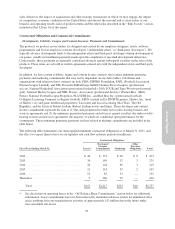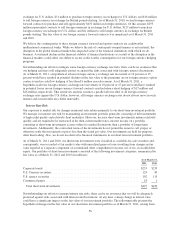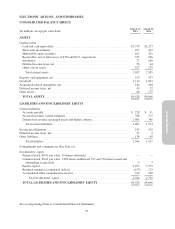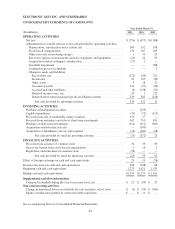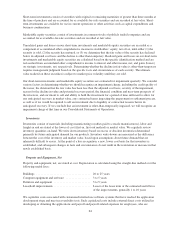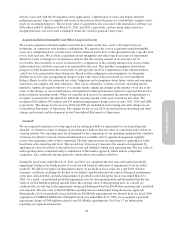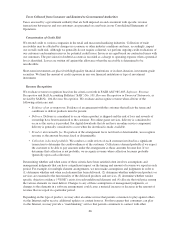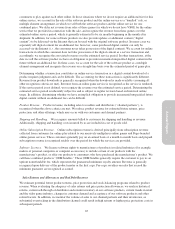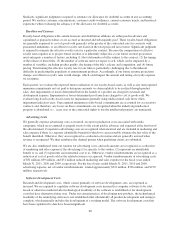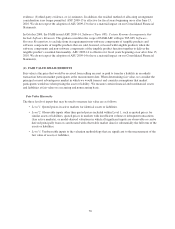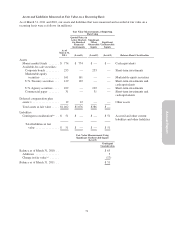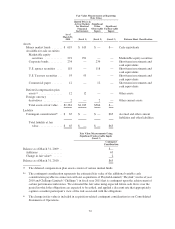Electronic Arts 2011 Annual Report Download - page 139
Download and view the complete annual report
Please find page 139 of the 2011 Electronic Arts annual report below. You can navigate through the pages in the report by either clicking on the pages listed below, or by using the keyword search tool below to find specific information within the annual report.
Annual Report
ELECTRONIC ARTS INC. AND SUBSIDIARIES
NOTES TO CONSOLIDATED FINANCIAL STATEMENTS
(1) DESCRIPTION OF BUSINESS AND SUMMARY OF SIGNIFICANT ACCOUNTING POLICIES
We develop, market, publish and distribute game software and content that can be played by consumers on a
variety of platforms, including video game consoles (such as the Sony PLAYSTATION 3, Microsoft Xbox 360
and Nintendo Wii), personal computers, mobile phones (such as the Apple iPhone and Google Android
compatible phones), tablets and electronic readers (such as the Apple iPad and Amazon Kindle), the Internet, and
handheld game players (such as the PlayStation Portable (“PSP”) and the Nintendo DS and 3DS). Some of our
games are based on content that we license from others (e.g., FIFA, Madden NFL, Harry Potter, and Hasbro’s toy
and game intellectual properties), and some of our games are based on our own wholly-owned intellectual
property (e.g., The Sims, Need for Speed, and Dead Space). Our goal is to publish titles with global mass-market
appeal, which often means translating and localizing them for sale in non-English speaking countries. In addition,
we also attempt to create software game “franchises” that allow us to publish new titles on a recurring basis that
are based on the same property. Examples of this franchise approach are the annual iterations of our sports-based
products (e.g., FIFA, Madden NFL, and NCAA Football), wholly-owned properties that can be successfully
sequeled (e.g., The Sims, Need for Speed, and Battlefield) and titles based on long-lived literary and/or movie
properties (e.g., Harry Potter).
A summary of our significant accounting policies applied in the preparation of our Consolidated Financial
Statements follows:
Consolidation
The accompanying Consolidated Financial Statements include the accounts of Electronic Arts Inc. and its
wholly-owned subsidiaries. Intercompany balances and transactions have been eliminated in the consolidation.
Fiscal Year
Our fiscal year is reported on a 52- or 53-week period that ends on the Saturday nearest March 31. Our results of
operations for the fiscal years ended March 31, 2011 and 2009 each contained 52 weeks and ended on April 2,
2011 and March 28, 2009, respectively. Our results of operations for the fiscal year ended March 31, 2010
contained 53 weeks and ended on April 3, 2010. For simplicity of disclosure, all fiscal periods are referred to as
ending on a calendar month-end.
Use of Estimates
The preparation of consolidated financial statements in conformity with accounting principles generally accepted
in the United States requires us to make estimates and assumptions that affect the amounts reported in our
consolidated financial statements and the accompanying notes. Such estimates include sales returns and
allowances, provisions for doubtful accounts, accrued liabilities, service period for deferred net revenue, income
taxes, losses on royalty commitments, estimates regarding the recoverability of prepaid royalties, inventories,
long-lived assets, assets acquired and liabilities assumed in business combinations, certain estimates related to
the measurement and recognition of costs resulting from our share-based payment awards, deferred income tax
assets and associated valuation allowance as well as estimates used in our goodwill, short-term investments, and
marketable equity securities impairment tests. These estimates generally involve complex issues and require us to
make judgments, involve analysis of historical and future trends, can require extended periods of time to resolve,
and are subject to change from period to period. In all cases, actual results could differ materially from our
estimates.
Cash, Cash Equivalents, Short-Term Investments and Marketable Equity Securities
Cash equivalents consist of highly liquid investments with insignificant interest rate risk and original or
remaining maturities of three months or less at the time of purchase.
63


